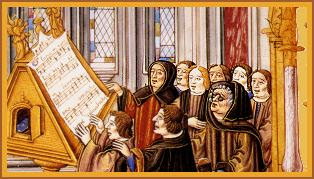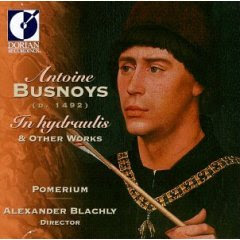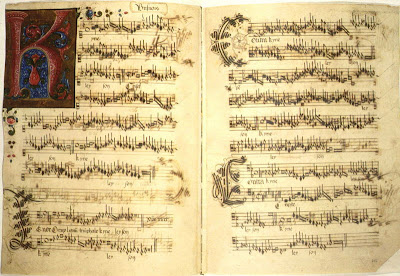
Johannes Ockeghem (1430-1495)
Missa "L'Homme Arme"
[Kyrie]
[Sanctus]
Requiem
[Introit]
[Sanctus]
[Ma Mistresse]
Missa "Ma Mistresse" ("My Mistress")
Johannes Ockeghem (also Jean de... Okeghem, Ogkegum, Okchem, Hocquegam, Ockegham -- other variant spellings are also encountered!) (c. 1410/1430, Saint-Ghislain, Belgium - February 6, 1497, Tours, France) was the most famous composer of the Franco-Flemish School in the last half of the 15th century, and is often considered the most influential composer between Dufay and Josquin des Pres. In addition to being a renowned composer, he was also an honored singer, choirmaster, and teacher.
[Alma Redemptoris Mater]
The spelling of Ockeghem's name comes from a supposed autograph of his which survived as late as 1885, and as reported by E. Giraudet, a historian in Tours; the document has since been lost. In 15th-century sources, the spelling "Okeghem" predominates.
The birthdate of Ockeghem is controversial, and dates as early as 1410, and as late as 1430 have been proposed.
The earlier date is based on the possibility that he knew Binchois in Hainaut before the older composer moved from Mons to Lille in 1423. Ockeghem would have to have been younger than 15 at the time. This particular speculation derives from Ockeghem's reference, in the lament he wrote on the death of Binchois in 1460, to a chanson by Binchois dated to that time.
In this lament Ockeghem not only honored the older composer by imitating his style, but also revealed some useful biographical information about him.
The comment by the poet Guillaume Crétin, in the lament he wrote on Ockeghem's death in 1497, "it was a great shame that a composer of his talents should die before 100 years old," is also often taken as evidence for the earlier birthdate for Ockeghem.
Recent research has shown that Ockeghem was born in the town of Saint-Ghislain; many older biographies state that he was either born in the town of his name or in the neighboring town of Dendermonde in East Flanders (now part of modern Belgium), part of the Duchy of Burgundy. Details of his early life are lacking. Most likely he was a native speaker of French.
Like many composers in this period, he started his musical career as a chorister, although the exact location of his education is unknown: Mons, a nearby town that had at least two churches with competent music schools, has been suggested.
The first actual documented record of Ockeghem's musical activity is from the cathedral of Notre Dame in Antwerp, where he was employed in 1443 and 1444, likely singing under the direction of Johannes Pullois, whose employment also dates from that year.
This church was another distinguished establishment, and it was likely here that Ockeghem became familiar with the English compositional style, which was decisive in formation of late 15th-century musical practice on the continent.
Between 1446 and 1448 Ockeghem served Charles, Duke of Bourbon, in Moulins (France)[10]. During this service he became the first among the singing chaplains to appear in the court records, Around 1452 he moved to Paris where he served as maestro di cappella to the French court, as well as treasurer to the St. Martin cathedral in Tours.
In addition to serving at the French court -- both for Charles VII and Louis XI -- he held posts at Notre Dame Cathedral and St. Benoît. He is known to have traveled to Spain in 1470, as part of a diplomatic mission for the King, which was a complex affair attempting both to dissuade Spain from joining an alliance with England and Burgundy against France, and to arrange a marriage between Isabella of Castile and Charles, Duke of Guyenne (the brother of king Louis XI).
After the death of Louis XI (1483), not much is known for certain about Ockeghem's whereabouts, though it is known that he went to Bruges and Tours, and he probably died in the latter town since he left a will there. An indication of the renown in which Ockeghem was held is the number of laments written on his death in 1497; among the most famous of the musical settings of these many poems is Nymphes des bois by Josquin des Prez.
Ockeghem probably studied with Gilles Binchois, and at the very least was closely associated with him at the Burgundian court. Since Antoine Busnois wrote a motet in honor of Ockeghem sometime before 1467, it is probable that those two were acquainted as well; and writers of the time often link Dufay, Busnois and Ockeghem. Although Ockeghem's musical style differs considerably from that of the older generation, it is probable that he acquired his basic technique from them, and as such can be seen as a direct link from the Burgundian style to the next generation of Netherlanders, such as Obrecht and Josquin.
Ockeghem was a reasonably prolific composer, given the length of his career and extent of his reputation, and some of his work is lost. Surviving works include some 14 masses (including a Requiem mass), an isolated Credo (Credo sine nomine), 5 motets, a motet-chanson (a deploration on the death of Binchois), and 21 chansons.
Thirteen of Ockeghem's masses are preserved in the Chigi codex, a Flemish manuscript of around 1500.
His Missa pro Defunctis is the earliest surviving polyphonic Requiem mass (a setting by Dufay, possibly earlier, has been lost). Some of his works, alongside compositions by his contemporaries, are included in Petrucci's Harmonice musices odhecaton (1501), the first collection of music to be published using moveable type.
Dating Ockeghem's works is controversial, as there are almost no external references allowing precise dating, excepting of course the death of Binchois (1460) for which Ockeghem composed a motet-chanson. The Missa Caput is almost certainly an early work, since it follows on an anonymous English mass of the same title dated to the 1440's, and his late masses may include the Missa Ma maistresse and Missa Fors seulement, based on both his innovative treatment of the cantus firmus, and his tendency to write more and more homogenous textures later in his life.
Ockeghem used the cantus firmus technique in about half of his masses; the earliest of these masses use head-motifs at the start of the individual movements, a practice which was common around 1440 but which was archaic after around mid-century.
Two of his masses, Missa Ma maistresse and Missa Fors seulement, are based on chansons he wrote himself, and use more than one voice of the chanson, foreshadowing the parody mass techniques of the 16th century. In his remaining masses, including the Missa Mi-mi, Missa cuiusvis toni, and Missa prolationum, no borrowed material has been found, and the works seem to have been freely composed.
Ockeghem would sometimes place borrowed material in the lowest voice, such as in the Missa Caput, one of three masses written in the mid-15th century based on that fragment of chant from the English Sarum Rite.[
Other characteristics of Ockeghem's compositional technique include his liking for varying the rhythmic shape of voices, so as to maintain their independence.
A strong influence on Josquin Des Prez and the subsequent generation of Netherlanders, Ockeghem was famous throughout Europe for his expressive music, although he was equally renowned for his technical prowess.
Two of the most famous contrapuntal achievements of the 15th century include the astonishing Missa prolationum, which consists entirely of mensuration canons, and the Missa cuiusvis toni, designed to be performed in any of the different modes, but even these technique-oriented masterpieces demonstrate his insightful use of vocal ranges and uniquely expressive tonal language.
Being a renowned bass singer himself, his use of wide-ranging and rhythmically active bass lines sets him apart from many of the other composers in the Netherlandish Schools.
To commemorate his death, Josquin Des Prez composed the motet La déploration de la mort de Johannes Ockeghem, a setting of the poem Nymphes des bois by Jean Molinet. An unusally large number of laments appeared after the death of this great composer. Some of the authors of these poems included Jean Molinet and Desiderus Erasmus; Johannes Lupi provided another musical setting.
Works
Masses
Missa sine nomine
Missa sine nomine (incomplete: only Kyrie, Gloria and Credo exist)
Missa Au travail suis
Missa Caput
Missa cuiusvis toni
Missa De plus en plus
Missa Ecce ancilla Domini
Missa Fors seulement (has not survived complete: only Kyrie, Gloria and Credo remain)
Missa L'homme armé
Missa Ma maistresse (only Kyrie and Gloria extant)
Missa Mi-mi (also known as the Missa quarti toni)
Missa prolationum
Missa quinti toni
Missa pro defunctis (Requiem)
Credo sine nomine (Mass section)
Marian antiphons
Alma Redemptoris mater
Ave Maria
Salve regina
Others
Intemerata Dei mater (possibly written 1487)[28]
Ut heremita solus
Motet-chanson
Mort tu as navré/Miserere (lamentation on the death of Gilles Binchois, probably written in 1460)
Chansons
Two voices
O rosa bella (ballata) (Ai lasso mi - Bedyngham/Dunstable?)
Three voices
Aultre Venus estes
Au travail suis (attrib: possibly by Barbingant)
Baisiés moy dont fort
D'un autre amer
Fors seulement contre
Fors seulement l'attente
Il ne m'en chault plus
La despourveue et la bannie
L'autre d'antan
Les desléaux ont la saison
Ma bouche rit
Ma maistresse
Prenez sur moi
Presque transi
Quant de vous seul
Qu'es mi vida preguntays
Se vostre cuer eslongne
Tant fuz gentement resjouy
Ung aultre l'a
Three or four voices
J'en ay dueil
Four voices
S'elle m'amera/Petite camusette
***
Glasses, also called eyeglasses or spectacles, are frames bearing lenses worn in front of the eyes, normally for vision correction, eye protection, or for protection from UV rays.
The first suspected recorded use of a corrective lens may have been by the emperor Nero in the 1st century, who was known to watch the gladiatorial games using an emerald.
Corrective lenses were said to be used by Abbas Ibn Firnas in the 9th century.
He had devised a way to finish sand into glass, which until this time was secret to the Egyptians. These glasses could be shaped and polished into round rocks used for viewing and were known as reading stones. Sunglasses, in the form of flat panes of smoky quartz, protected the eyes from glare and were used in China in the 12th century or possibly earlier. However, they did not offer any corrective powers.
Around 1284 in Italy, Salvino D'Armate is credited with inventing the first wearable eye glasses.
The earliest pictorial evidence for the use of eyeglasses, however, is Tomaso da Modena's 1352 portrait of the cardinal Hugh de Provence reading in a scriptorium. Other early examples would be the depictions of eyeglasses found north of the Alps in an altarpiece of the church of Bad Wildungen, Germany, in 1403; and Johannes Ockeghem's spectacles in the picture at top.
[8450 Ilorin / 8430 Ockeghem / 8430 Busnois]









